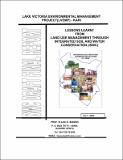| dc.description.abstract | River Nyando is one of seven major rivers within the Kenyan side of the Lake Victoria
Drainage Basin. The other six rivers are Sio, Nzoia, Yala, Mara, Sondu-Miriu and Kuja-
Migori. The Nyando and Nzoia rivers have been the main sources of seasonal flooding in
downstream areas before their waters enter Lake Victoria.
The Nyando has its tributaries originating from the Nandi and Tindiret Hills in South and
North Nandi Districts and Londiani, Tindiret and West Mau Forests in Kericho and Nakuru
Districts. River Nyando has a total length of 170 km and a catchment area of 3450 km2. The
Nyando Drainage Basin consists of five main sub-catchment areas namely:- Nyando-Nandi;
Nyando-Kericho; Awach-Kano; Nyaidho-Kano; and Nyando-Kano. More than 50% of the
total water discharge of the Nyando comes from the Nyando-Nandi sub-catchment area.
River Nyando traverses Londiani, Kipkelion and Sigowet areas of Kericho District and
Koru, Muhoroni, Chemelil, Lower Nyakach and Kano Plains areas of Nyando District.
Londiani, West Mau, Kipkelion, Sigowet and Koru areas form the highlands zone whereas
Muhoroni, Chemelil, Lower Nyakach and Kano Plains form the lowlands zone of the
drainage basin. The highlands zone is characterized by a very rugged terrain particularly in
Kipkelion, Aldai, Kaptumo, and Tinderet Divisions. The mean annual rainfall ranges
between 1000 mm (in Tinderet Forest) and 1600 mm (in Kipkelion). The total land areas
covered by West Mau Forest, Kipkelion and Londiani are 573 km2 , 441 km2 and 238 km2
respectively. The average annual rainfall for these areas is 1660 mm, 1390 mm and 1250 mm
respectively. The dominant soils in the highlands zone include Nitisols, Phaeozems, Luvisols
and Cambisols. These soils are well drained, deep and dark reddish brown sandy clay loam to
clay. The Phaeozems and Cambisols are dominant in Kipkelion and have a rocky or stony
surface. The Nitisols are found in the West Mau Forest area. Most of the soils in the
highlands are overlain by humic topsoil | en_US |

